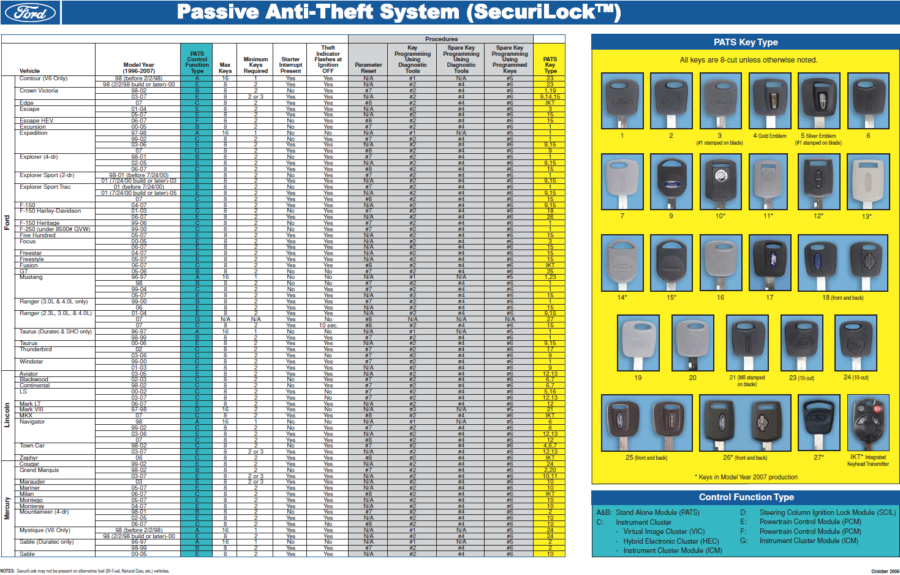| B1213 | Less than 2 (or 3 if equipped w/Valet key) keys programmed to the system. |
| B1232/B2103 | Transceiver internal antenna damaged. Replace transceiver. |
| B1342 | ECU is defective (EEPROM in PCM is not working — replace PCM). PATS related when stored in PCM only. |
| B1600 | Non-PATS Key or damaged key. |
| B1601 | Unprogrammed encoded ignition key detected (leave ignition on for 20 seconds before trying a programmed key, in Anti-Scan Mode). |
| B1602 | Partial detection of encoded ignition key. |
| B1681 | Transceiver signal not detected. |
| B2141 | Non-Volatile Memory (NVM) configuration failure — No PCM ID stored in PATS. |
| B2139/U2510 | PCM ID does not match between the PCM and PATS control (PATS/ICM/VIC/HEC/SCIL). |
| B2431 | Key program failure (defective key or transceiver). |
| U1147/U1262 | Communications issue, SCP (J1850), between PCM and PATS control (PATS/ICM/ VIC/HEC/SCIL). |
| U1900/U0100 U2511/B2009 | Communications issue, CAN (J2284), between PCM and PATS control (ICM). |
| P1260 | PCM disabled the vehicle because of a PATS concern. Retrieve DTCs from applicable PATS control function (PATS/ICM/VIC/HEC/SCIL). |
Ford PATS Relearn Procedure

DTC
Description
Description
Is is not a PATS issue, if:
- The “Service Engine Soon” light is illuminated. (Investigate PCM system)
- There is no communications with PCM: PCM will always communicate on the diagnostic link regardless of theft status. (Investigate PCM system)
- Engine stalls on road: Once the engine runs for one second, PATS CANNOT disable the engine. Running stalls are not PATS related
- Remote Entry/Keyless Entry problems: PATS is completely separate from the Remote Entry/Keyless Entry
- There is a no-crank problem on vehicles without PATS Starter disable. Check chart, on reverse side, for presence of Starter
- PATS Theft Indicator flashes every 2 seconds at Ignition This is normal operation for PATS to act as a visual theft deterrent. See chart on reverse side for applicable system.
- PATS Theft Indicator stays on for 2 or 3 seconds (depending on system type) at Ignition RUN or START and then off: This is normal operation for PATS proveout on all vehicles except LS and Thunderbird.
Procedures
|
Key Programming Using Diagnostic Tools |
Procedure #1
1 key required. Cycle key to RUN. Enter “Ignition Key Code Erase.” Disconnect Tool and leave key in RUN for 20 seconds. Cycle key to OFF and then RUN. Procedure #2 2 keys required. Cycle key 1 to RUN. Enter Security Access on the PATS control function module. Select “Ignition Key Code Erase.” Disconnect Tool and leave key in RUN for 20 seconds. Cycle key 1 to OFF, then RUN, and back to OFF. Cycle key 2 to RUN. Procedure #3 2 keys required. Cycle key 1 to RUN. Select “Ignition Key Code Erase.” Disconnect Tool and leave key in RUN for 20 seconds. Cycle key 1 to OFF, then RUN, and back to OFF. Cycle key 2 to RUN. |
| Spare Key Programming Using Diagnostic Tools | Procedure #4
Cycle an unprogrammed key in ignition to RUN. Enter Security Access on the PATS control function module. Select “Ignition Key Code Program.” Disconnect Tool and leave key in RUN for 20 seconds. |
| Spare Key Programming Using Programmed Keys | Procedure #5
1 key required. Cycle key 1 to RUN, then OFF. Cycle new key to RUN. Procedure #6 2 keys required. Cycle key 1 to RUN, then OFF. Cycle key 2 to RUN, then OFF. Cycle new key to RUN. |
|
Replacing PATS Control Module or PCM |
Procedure #7
Cycle a key in ignition to RUN. Enter Security Access on the PATS control function module. Select “Parameter Reset” and then Exit Security Access. Perform a PCM Keep Alive Memory (KAM) reset. Procedure #8 Cycle a key in the ignition to RUN. Enter Security Access on the PATS control function module. Select “ICM /PCM Parameter Reset.” Select “PCM /TCM Parameter Reset” and then Exit Security Access. (for type F) |
Things to do:
It is not a PATS issue, if:
- Review Service Procedures and Technical Service Bulletins (TSBs) for latest
- Disconnect the diagnostic tool for 20 seconds before cycling ignition to OFF, ACC, or RUN.
- When replacing ignition keys, make sure the owner throws out ALL old
- Disconnect battery cables when replacing PATS module, ICM, VIC, HEC, SCIL, PCM, or
- Look for fault codes in The PATS function will store fault codes when the PCM records a P1260.
- Be certain of the vehicle model Use only parts & keys specified for the appropriate model year.
- Check to make sure the issue is not with multiple PATS keys, small electronic devices that can be used to purchase gasoline, or other items on same key ring.
- Check to ensure vehicle does not have an aftermarket remote starter. Disable any Remote Starter equipment, especially anything nearby the PATS Ford FCSD Dealer installed Remote Starter systems are approved for use in Ford vehicles.
- Check to ensure vehicle does not have an aftermarket engine immobilizer. The Ford FCSD aftermarket remote entry system comes with a starter interrupt that should be disabled on PATS equipped vehicles.
- If the Alarm sounds when the ignition is turned to RUN or START, refer to the Perimeter Alarm section of the workshop
Things NOT to do:
- Do not use aftermarket keys that are NOT Ford qualified.
- Do not reprogram keys unless a defective key or control function has been replaced. Reprogramming keys does not fix any known problem by
- Do not perform more Security Access functions than required: Perform only the functions specified in the Shop manual for this repair. Selection of extra functions may continue the no-crank condition.
